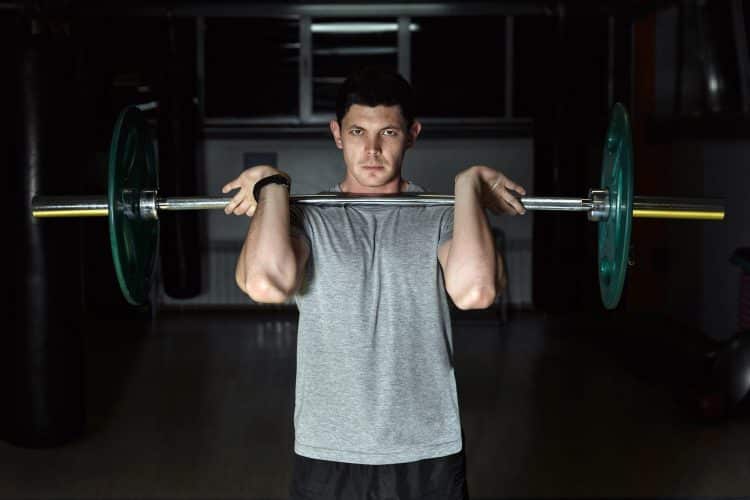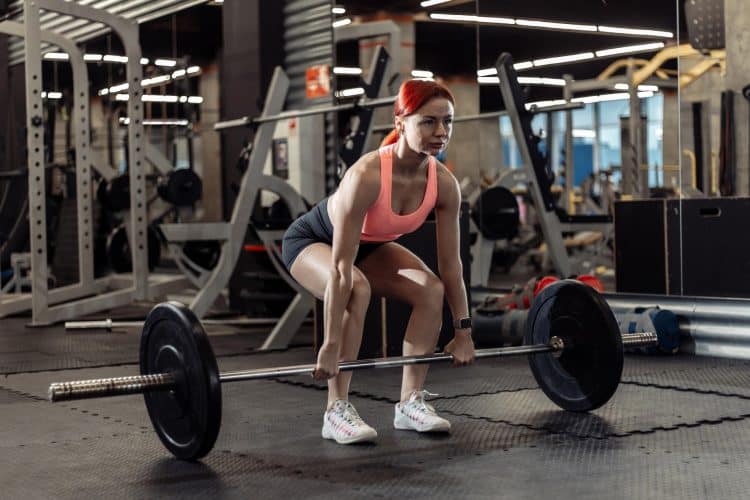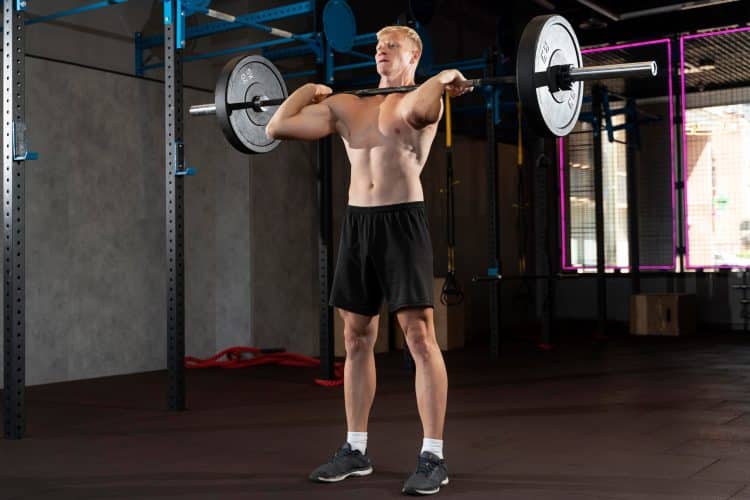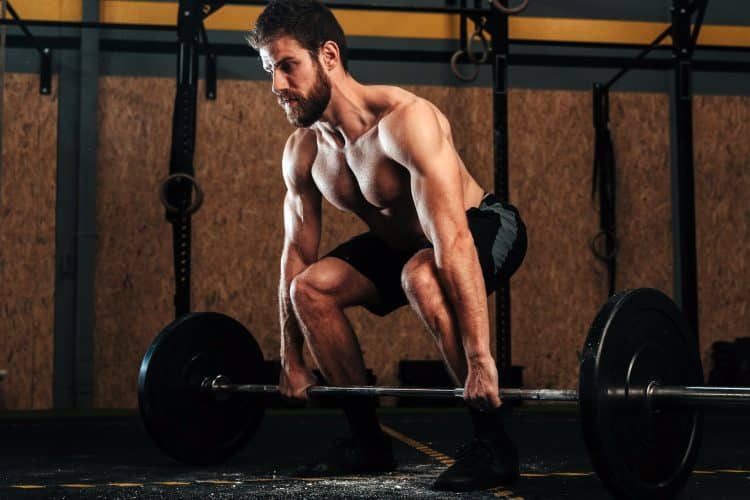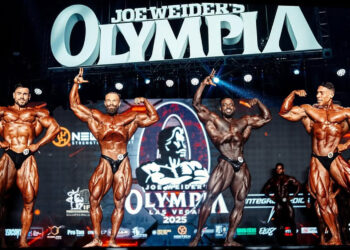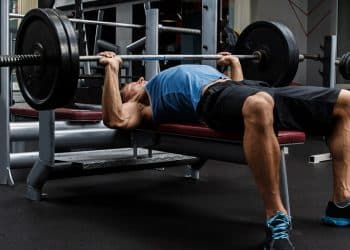The power clean is an advanced exercise that works almost every muscle group in your body. It is a simplified version of its sister Olympic lift — clean and jerk.
The functional exercise requires the use of many muscle groups and coordinated skills. If you thought the three powerlifting moves — deadlift, squat, and bench press — were complicated, wait until you try the power clean.
Although the power clean has always been a popular exercise, especially in the weightlifting community, it got a life of its own after it became a staple in CrossFit workouts.
The power clean is a full-body exercise that helps build strength and explosiveness. Plus, since it is a full-body exercise, the power clean is incredibly effective at helping torch body fat.
The lift comes with a steep learning curve and is a high-impact exercise. Focus on perfecting your form while performing the power clean before moving on to bigger weights.
Breaking the exercise into several phases and perfecting the technique in each step is one of the fastest (and safest) ways of mastering the power clean.
Level Up Your Fitness: Join our 💪 strong community in Fitness Volt Newsletter. Get daily inspiration, expert-backed workouts, nutrition tips, the latest in strength sports, and the support you need to reach your goals. Subscribe for free!
Conventional power clean involves performing the exercise with a barbell. However, you could do the lift with dumbbells and kettlebells after you’ve nailed down your technique.
The power clean should also be the first step towards learning more complex movements like the clean and jerk, power snatch, and clean and press.
In this article, you’ll learn about the average power clean by gender, weight, and experience level, how to perform the power clean with the correct form, and its benefits.
Average Power Clean By Weight, Experience Level, and Gender
The power clean is an advanced exercise. The weight you’ll be able to lift will depend on your body weight, sex, and experience level.
The numbers mentioned in the table are the one-rep max (1RM) based on an individual’s body weight and experience level. Do not try to perform the exercise with weights mentioned in the table without prior training and warm-up.
Average Power Clean Weight For Male
The average male power clean depends on several factors, including a lifter’s age, weight, and experience level. It shouldn’t come as a surprise that heavier folks with more lifting experience can power clean more weight than a lighter untrained fellow.
Below is the Male Power Clean Standards chart from Symmetric Strength:
| Body Weight (pounds) | Untrained | Novice | Intermediate | Proficient | Advanced | Exceptional | Elite | World Class |
| 114 | 60 | 90 | 120 | 150 | 175 | 200 | 225 | 250 |
| 123 | 65 | 95 | 130 | 160 | 190 | 215 | 240 | 270 |
| 132 | 70 | 105 | 140 | 170 | 200 | 230 | 260 | 285 |
| 148 | 75 | 115 | 150 | 190 | 220 | 255 | 285 | 315 |
| 165 | 80 | 125 | 165 | 205 | 240 | 275 | 310 | 345 |
| 181 | 90 | 130 | 175 | 220 | 255 | 290 | 330 | 365 |
| 198 | 90 | 140 | 185 | 230 | 270 | 305 | 345 | 385 |
| 220 | 95 | 145 | 195 | 240 | 280 | 320 | 360 | 400 |
| 242 | 100 | 150 | 200 | 250 | 290 | 335 | 375 | 415 |
| 275 | 105 | 155 | 205 | 260 | 300 | 345 | 385 | 430 |
| 320 | 105 | 160 | 210 | 265 | 310 | 355 | 395 | 440 |
Per the data, world-class male athletes can lift four times as heavy on the power clean as individuals who do not train. At the same time, advanced lifters can lift almost twice as much as a beginner.
Average Power Clean Weight For Female
Like their male counterparts, the average power clean for women depends on factors like age, weight, and experience level.
Below is the Female Power Clean Standards chart from Symmetric Strength:
| Body Weight (pounds) | Untrained | Novice | Intermediate | Proficient | Advanced | Exceptional | Elite | World Class |
| 97 | 45 | 65 | 85 | 110 | 125 | 145 | 165 | 180 |
| 105 | 45 | 70 | 90 | 115 | 135 | 155 | 175 | 190 |
| 114 | 50 | 75 | 100 | 125 | 145 | 165 | 185 | 205 |
| 123 | 50 | 80 | 105 | 130 | 150 | 175 | 195 | 215 |
| 132 | 55 | 85 | 110 | 140 | 160 | 185 | 205 | 230 |
| 148 | 60 | 90 | 120 | 150 | 175 | 200 | 225 | 250 |
| 165 | 65 | 95 | 130 | 160 | 190 | 215 | 240 | 270 |
| 181 | 70 | 100 | 135 | 170 | 200 | 225 | 255 | 285 |
| 198 | 70 | 105 | 140 | 180 | 205 | 235 | 265 | 295 |
| 205 | 70 | 110 | 145 | 180 | 210 | 240 | 270 | 300 |
The above data indicates that world-class female athletes can lift four times as heavy as untrained individuals, and advanced lifters can power clean almost twice as much as a beginner, which is in line with the male performance on the compound lift.
Notably, untrained women in the 97 to 105-pound weight class can power clean the same amount of weight, that is, 45 pounds. Similarly, females in the 114 to 123-pound class can lift 50 pounds, and the 181 to 205-pound group can lift 70 pounds.
Overall Average Male and Female Power Clean
Interestingly, unlike the squat, bench press, or deadlift, the power clean strength does not rise linearly with an increase in weight for untrained lifters. It is evident in the charts above for both — men and women.
The average power clean for men in the 181 to 198 pounds group is 90 pounds, whereas women between 181 to 205 pounds can lift 70 pounds.
Here is what the overall average power clean weight for males and females looks like:
Level Up Your Fitness: Join our 💪 strong community in Fitness Volt Newsletter. Get daily inspiration, expert-backed workouts, nutrition tips, the latest in strength sports, and the support you need to reach your goals. Subscribe for free!
Overall Average Male Power Clean
Per the Centers for Disease Control and Prevention’s National Center for Health Statistics (CDC), an average American male weighs 197.8 pounds, meaning an average man who doesn’t lift can power clean 90 pounds or 140 pounds for a rookie lifter. [1]
Furthermore, the average power clean for an American intermediate lifter is 185 pounds, 230 pounds for proficient, 270 pounds for advanced, 305 pounds for exceptional, 345 pounds for elite, and 385 pounds for world-class athletes.
Overall Average Female Power Clean
Per the CDC data, an average American female tips the scales at 170.5 pounds. As per the table from Symmetric Strength, a 165-pound woman (closest to 170.5 pounds) with no lifting experience can power clean 65 pounds or 95 for a novice.
However, the average power clean rises to 130 pounds for an intermediate lifter, 160 pounds for proficient, 190 pounds for advanced, 215 pounds for exceptional, 240 pounds for elite, and 270 pounds for world-class athletes.
How to Power Clean
As mentioned earlier, the power clean is an advanced exercise. It involves lifting the weight off the floor and placing it on your shoulders in a single motion, meaning a lot can go wrong.
You need to ensure you’re performing the exercise with the correct form to get the best bang for your buck while reducing the chances of injury.
To better explain how to perform the power clean, let’s break it into five phases:
First Phase: Set-up
- Stand upright with your feet hip distance apart and place the barbell close to your shins.
- Squat down and grab the barbell with a wider than shoulder-width overhand grip.
- Keep your back straight and neck neutral throughout the exercise.
Second Phase: First Pull
- Extend at your knees and hips while pushing through your heels, and lift the bar while keeping it close to your body as you stand up straight.
- Keep your arms extended and heels on the ground as the bar travels upward.
- Continue lifting until the bar is at your thighs.
- Keep your core engaged throughout the movement.
Third Phase: Second Pull and Scoop
- Bend the knees slightly to prepare for the next quick succession of movements.
- Thrust your hips forward and pull the bar toward the chest.
- The explosiveness of this phase might result in the balls of your feet coming off the floor.
- Shrug your shoulders and flex your elbows to create power as you pull the bar through the final stage of this movement.
Fourth Phase: Catch
- Pull your body under the bar as you complete the third phase.
- Drop into a partial squat position while keeping your torso upright.
- Your elbows will snap forward (under the bar), and your shoulders will roll forward, creating a shelve for the bar.
- Catch the bar so it is resting on the front of your shoulders.
Fifth Phase: Stand and Return
- After finding stability with the bar resting on the front of your shoulders, stand up.
- After completing a rep, rotate your hands back around the bar to remove it from your shoulders. Gradually lower the bar back down to your thighs and then the floor.
- Repeat for recommended reps.
While this might sound like a lot, all these steps will become second nature with practice. Furthermore, if you’re a beginner, you could practice each of the five phases separately before performing one complete rep of the power clean.
Check out our power clean guide to learn how to perform the exercise for achieving muscle hypertrophy.
Benefits of Power Clean
Adding the compound (multi-joint) movement to your exercise arsenal entails the following benefits:
1. Builds Explosiveness
There is a reason why this exercise has power in its name. Power cleaning, especially heavier weights, requires you to blast through the lift.
A 2019 study found that adding power clean to your training regimen can significantly improve power development. [2]
2. Improves Coordination
The power clean has a lot of moving parts. You need to move your legs, arms, upper body, and neck in sync to perform the exercise with the correct form.
A 2021 study found that compound exercise can improve muscle and hand-eye coordination. [3]
3. Full-body Workout
While performing the power clean, posterior chain muscles — glutes, hamstring, and back — are involved during the initial lift. On the other hand, frontal muscles like the abs, delts, and quads are engaged during the catch phase.
4. Improves Body Composition
It is no secret that high-intensity resistance exercises like the power clean stimulate muscle growth and fat loss. They are a go-to for people on a body recomposition program.
5. Boosts Endurance
Since the power clean is a high-intensity full-body exercise, performing it regularly can improve your endurance and stamina, translating into better performance in other physical tasks.
6. Improves Balance
The power clean is an explosive exercise requiring you to start in a squat position, takes you to your toes, and involves catching the barbell on your shoulders before returning it to the floor. Mastering the lift can improve your balance as you need to offset your “center of mass” against the movement of the weight.
FAQs
I’m a beginner. How much weight should I lift on the power clean?
Beginners should begin practicing the movement with just an Olympic barbell. However, if you have a hard time completing the lift with the correct form, perform the power clean with a smaller bar.
Should bodybuilders add the power clean to their training routine?
Although the power clean is not an optimal exercise for inducing muscle hypertrophy, which is a bodybuilder’s ultimate goal, adding it to your training regimen can do no harm. It can help build strength, explosiveness, and coordination, which can help you avoid hitting a plateau.
You might also like:
- Average Bench Press By Age, Weight, Gender, and Experience Level
- Average Pull-Up and Chin-Up By Weight, Gender, and Experience Level
- Average Deadlift By Weight, Gender, and Experience Level
- Average Squat By Weight, Gender, and Experience Level
- Average Thigh Circumference in Males and Females
- The Average Calf Size for Men and Women
- Average Waist Size For Women and Men
- Average Biceps Size: How Do You Measure Up?
Wrapping Up
The power clean is a great exercise for weightlifters, CrossFitters, and anyone looking to improve their strength, explosiveness, mobility, balance, and coordination.
Use the charts from Symmetric Strength to check how you stack up against people in your weight class and experience level. Use the charts to assess your current situation, but do not let your ego get the better of you. Best of luck!
References
- McDowell MA, Fryar CD, Ogden CL, Flegal KM. Anthropometric reference data for children and adults: United States, 2003–2006. National health statistics reports; no 10. Hyattsville, MD: National Center for Health Statistics. 2008.
- James LP, Comfort P, Suchomel TJ, Kelly VG, Beckman EM, Haff GG. Influence of Power Clean Ability and Training Age on Adaptations to Weightlifting-Style Training. J Strength Cond Res. 2019 Nov;33(11):2936-2944. doi: 10.1519/JSC.0000000000002534. PMID: 29547489.
- Santos PDG, Vaz JR, Correia PF, Valamatos MJ, Veloso AP, Pezarat-Correia P. Intermuscular Coordination in the Power Clean Exercise: Comparison between Olympic Weightlifters and Untrained Individuals-A Preliminary Study. Sensors (Basel). 2021 Mar 9;21(5):1904. doi: 10.3390/s21051904. PMID: 33803182; PMCID: PMC7963197.

